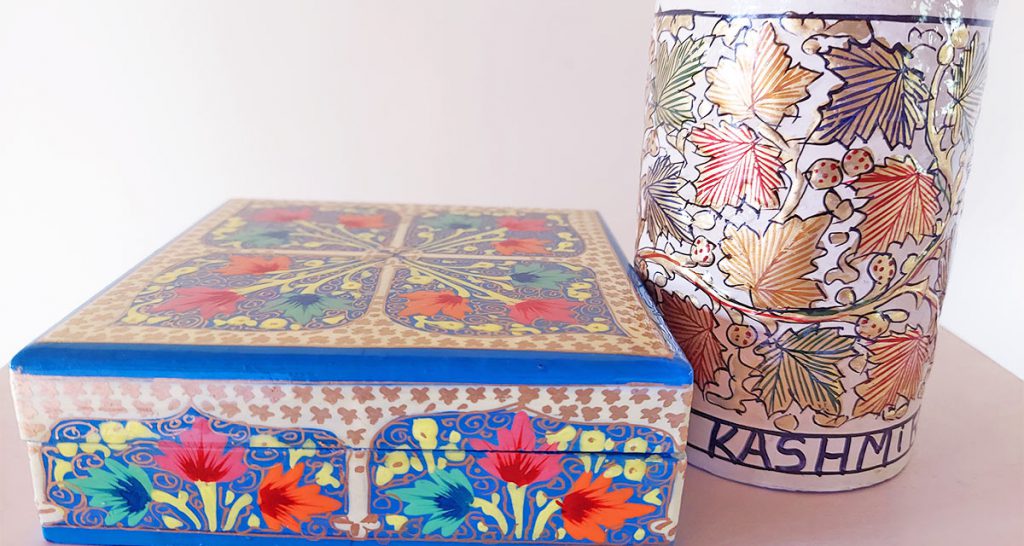Blog, Kashmiri Culture
PAPIER MACHE – The Story Behind The Amazing Art
The intricate patterns carved detail on a box, elegant colors on beautifully designed animal shapes, papier Mache is an amazing craft passed down generations to generations, for centuries. Having travelled from Central Asia but making its home in Kashmir, the fascinating art involves the creation of design by carving pulp of paper in various molds and shapes. The skilled Kashmiri artisans have years of experience, crafting scraps of paper into wonderful design crafts. But how does the craft come into the region of Kashmir?
The term, ‘papier Mache’ is derived from the French word, literally meaning ‘crushed paper’ and the art of paper mache was bought in Kashmir during the 14th century by a famous Persian mystic Mir Sayid Ali Hamdani along with his followers, many of whom were amazingly skilled craftsman. Along with the craft of paper mache, they were also experts at woodworking, carpet weaving among other things. Consequently, the idea of paper mache for decorative items was first adapted by King Zain Ul Abideen during the early 15th century which symbolized art and elegance, and the royal households were known to have beautiful pieces of paper mache for decorations.
The Mughal era in Kashmir blended the traditional art of paper mache along with newly found techniques and methods. Paper mache was applied on many surfaces, including woodwork and some of the extended work can still be seen around in some parts of Kashmir. The Madin Sahib Mosque, built in 1444 in Srinagar is one such example where the art of paper mache was applied to woodwork. Over time, the Kashmiri artisans added their touch to this art, hence infusing the age-old culture of Kashmir to the art brought from Central Asia.
Paper mache is a tedious process that broadly consists of two, depending upon the skill of the artisan and the complexity of the paper mache item – Sakhtsazi, and Naqashi. Sakhtsazi consists of fashioning the pulp of paper into design while Naqashi involves the painting process.
The paper pulp after being immersed in water for 4-5 weeks, is taken out, dried, and crushed to a pulp in a stone mortal known as Kanz. The mixture is taken out and is left to sundry with a mix of local adhesive. After some time, the paper pulp is carefully poured into the desired mold or crafted by hands into the desired shape. The paper pulp, still slightly wet after some time, is extracted from the mold by cutting it along the center. The object formed is known as kalib.
The kalb is smoothened and refined. The proper shape is given, and the coating of lacquer is applied along with a second coat of chalk powder and water. After some time, the object is hand-rubbed forwarded to Naqashi, the artisan.
The extremely detailed and extensive Naqashi work is performed by experienced artisans capable of having ‘supernatural’ skills. The design is painted with freehand with the use of sharply pointed brushes, the colors used are natural which adds a glossy look. The application of elegant colors especially Gold is used to create intricate designs with amazing details and accuracy. The Naqashi is a painstaking and slow process, which ultimately, determines the creation of raw pulp into a fascinating decorative item. The final step involves adding a layer of varnish to improve the appearance and add a finish to it.
The paper mache products are created in several designs and motifs such as flowers, birds, and even abstract art. Popular designs such as Hazaara, which attempts to display a thousand flowers into visually appealing shape or Gul andar Gul which translates in ‘flower within flower’ or ‘Chinar leaf’ which is a single chinar leaf along with amazing designs, all such point to the fact that the motifs selected are quite complex, yet visual treat for the eyes. ‘Arabesque’ is another rich design that includes the use of finely drawn lines of gold color on a dark surface, creating a masterpiece whose roots lie deep in history.
Article by Arbab Khan

